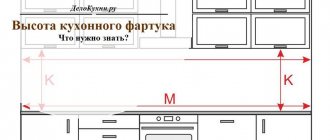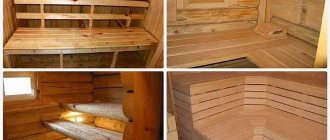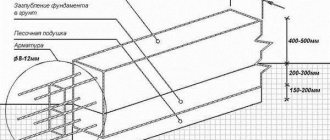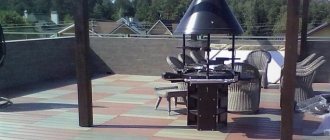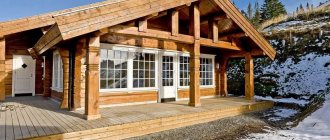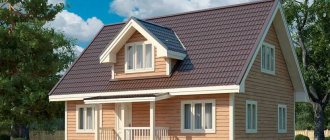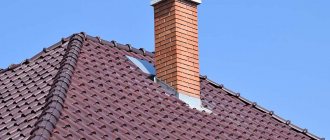The attic design of the attic allows you not only to increase the living space of the house, but also to make the structure unusual and beautiful. Moreover, a building with this type of roof can be made in almost any style. The mansard type roof, the design options of which can be very different, is found both in urban areas and in rural areas. Let's look at how to create such a design yourself, and find out what its features are.
Mansard roof - options
Functions and planning solutions
The functional and planning aspect of using the attic floor is determined mainly by the purpose of the building, and the planning features are related to the structure of the building and the rooms below. The attic floor can occupy the entire area of the building, or part of it, but, as a rule, within the limits of the underlying walls of the base building. Architectural and planning solutions can have a wide range, and premises can have any area and configuration.
When designing an attic floor, the choice of a planning option should be based on an analysis of the planning scheme of the base building, determined by studying the social needs of a given residential building and made in accordance with current regulatory requirements.
It is necessary to distinguish between three main types of attic floors:
- attic floor with the formation of a separate floor on one level;
- attic floor with two-level development;
- an attic floor with a spatial organization of a mezzanine floor with a two-level development of the upper floor of the base building.
Interior
When designing the interior of the attic floor, you should take into account some characteristic geometric shapes of the premises. We are talking about the placement of stairs, the furnishings of the bathroom and toilet, kitchen, as well as the placement of doors. The free height of staircases in relation to sloping roof surfaces should be taken into account. There are no difficulties when the direction of the stairs is parallel to the slope of the roof or the stairs are placed along the middle axis of the building. Free height is usually not a problem, but the placement of possible parts and components of the roof structure should be taken into account.
The furnishings of the bathroom and toilet should be taken into account the sloping surfaces of the roof, limiting the full height.
Placing doors can be challenging not only because of determining the height of the doorway itself. Here it is also necessary to take into account the unhindered opening of the door, taking into account the sloping wall.
Calculation of the area of the house.
The calculator uses simple values obtained from measuring the building and the thickness of the walls. The result is approximate, but not labor-intensive and will allow you to calculate the area of the house quickly, without detailed and painful internal measurements.
There are several ways to calculate the total area of the house:
1. the easiest way to calculate the approximate approximate total area of the house is to take measurements of the house from the outside and multiply the width by the length and the number of floors, then measure the thickness of the external walls and the perimeter multiplied by the thickness and multiplied by the number of floors - this will be the theoretical area of the walls (projection area to the floor), subtract the area of the walls from the first value and get the area of the house.
2. Measure the dimensions of all rooms, calculate the areas of all rooms and add up the results. This method is much more accurate, but much more labor-intensive.
Fire requirements
Fire safety requirements, especially evacuation routes for the attic floor, depend on the planning structure of the base building: if the functions of the base building and the functions of the attic floor coincide, the staircase-elevator assembly of the building to which the attic is adjacent is used for escape routes; if the functions of the base building and the attic floor do not coincide, creating escape routes requires the installation of special communications, which can be located inside or outside the building and have isolated exits, including between two buildings.
It is allowed that there are no exits to the staircase from each floor of an apartment on two levels, provided that the premises are located no higher than the 6th floor and the apartment is provided with an additional exit. It is allowed to install emergency exits into the common staircase from creative workshops, provided that communication through the vestibule is possible.
When placing offices and offices in the attics of residential buildings with no more than 9 floors, entrances and emergency exits must be isolated from the residential part of the buildings. It is allowed to accept staircases of the residential part of the building as a second emergency exit, while the exit is provided through a vestibule with fire doors. A roof window can serve as a rescue opening through which people from the premises can be evacuated.
Video description
Watch the video of the attic interiors:
Studio, office or library
A great idea for creative people is to arrange a small attic as an office or studio. Suitable for those who work at home or do part of their work there. The attic is best suited for a studio, as it is distinguished by its peculiar isolation from other rooms of the house. This guarantees silence, a creative mood, and the ability to calmly concentrate on the task at hand.
Study in the attic Source senator064.com
This is also convenient for rational use of space in the house. In a private house, it is sometimes difficult to allocate a separate room for a workshop or office, but there is no need to burden the interior of the bedroom or living room with a desk and other accessories.
You can decorate the room in the same style as the entire house. You can also make the interior more classic, typical of modern offices. It is important to choose open shelves for books, closed shelves for working tools, using all available space to the maximum.
If the attic is very small in size, you should not reduce its space even further by covering the beams with plasterboard or a suspended ceiling.
Features of the design of the living room in the attic
The last floor can be equipped as the main or additional living room in the house. It all depends on the size of the attic. If a room has skylights, they make it one of the most illuminated rooms in the house. Such structures not only provide a large flow of natural light, but also create the opportunity to view the surrounding area.
The living room on the attic floor is located opposite the windows Source www.mrdoors.ru
The wall on the gable of the building can be used to arrange a video zone or install an artificial fireplace. And in places with the lowest ceiling height, place a small sofa and armchairs. The finishing should also be done in white, pastel or nude colors with the addition of a couple of bright accents.
Plastic, glass, light furniture, all kinds of mirror or glass surfaces, lighting fixtures, and shiny fittings will make the living room in the attic even more cozy and atmospheric. Although these recommendations do not prohibit lovers of brighter shades from using their imagination and making more radical design decisions.
Cozy living room Source prorab.help
To decorate windows, you should choose a translucent fabric; thick curtains and blinds are suitable. In terms of style, different options are suitable for decorating the living room - classic, retro, hi-tech, modern modern, Provence.
A great option for wine lovers and guests is a combination of a living room and a tasting room. To arrange such a room, low wine cabinets located in areas of the lowest ceiling height, a small display cabinet for dishes, small sofas and a buffet are suitable. It turns out to be a great place to gather with friends over a glass of wine.
Important rules for designing an attic floor
The choice of planning option for the attic should be based on an analysis of the layout of the base building.
A huge role, depending on the level of visual perception, belongs to the lines and shapes determined by the geometry of the roof. An important condition for the placement of attic rooms is their relationship with the communication structure of the building - the foundation.
It is necessary to interact between the designed and existing engineering systems and ensure their collaboration. (In cases where the functions of the attic do not coincide with the functions of the main building, the development of special technical solutions is required).
Of particular importance are the shape and dimensions of the premises, the choice of translucent fencing (vertical or inclined windows), their placement, taking into account the construction of the interior in conjunction with the formation of architecture.
The structural design, material of enclosing structures and attic parts are determined taking into account the unity of the design and architectural forms of the base building (The use of lightweight structures, parts and products is the main requirement).
An attic with a steeply pitched roof requires a special approach to choosing roofing material, providing thermal protection, sealing and waterproofing.
The construction of an attic without relocating the residents of the main building requires a special method for maximum safety of work, limiting the weight of structures and parts, and constructing protection and safety elements.
Choosing the right style
The owner of the house and apartment independently chooses the stylistic direction in which the attic room will be decorated. But, there are a number of options that designers use most often. Their choice is related to the characteristics of the attic spaces and the possibilities for their comfortable arrangement.
Among the styles that are optimal for decorating an attic are:
- Provence . It is characterized by artificially aged furniture, bleached wood and delicate summer colors: a combination of green, lemon, blue, lavender shades.
Bedroom in Provence style Source lavandadecor.ru
- Country is a style similar to Provence, only in the American style. It is distinguished by the choice of rough wooden furniture, checkered fabrics, and cowboy paraphernalia.
- Alpine chalet . The style is perfect for decorating a fireplace or living room. The main attributes are a fireplace, soft leather furniture, wooden ceiling beams, and a lot of additional decor.
- Loft is a popular modern style in which the interior decoration is made of brickwork, gray concrete, communications are not hidden.
- Modern modern with characteristic functionality, practicality, simplicity, a combination of pastel and dark shades.
- High-tech - the presence of chrome and glass parts in the interior, strict forms, monotony, strict minimalism.
Attic floor structures
The design and geometry of the roof determines the architectural form of the crowning part of the building, and this, in turn, is the need to create unity of structural and architectural solutions in conjunction with the internal space determined by the functional purpose.
The choice of one or another architectural and construction system for the attic floor includes the determination of the load-bearing structure and fencing, as well as the organization of construction work at the site in the built-up part of the city.
For attic floors, it is recommended to choose lightweight structures and materials, since, on the one hand, their transportation to the floor should be as easy as possible, and on the other, the dead weight of the structures should be minimal, taking into account the load that will be transferred to the existing building.
These premises generally indicate that structures should be selected from wood-based materials or thin-walled cold-formed metal profiles. The use of stone and concrete materials to create a load-bearing structure for the attic floor on a building being restored or newly constructed is not recommended.
The roofing covering must meet the same prerequisites, that is, it must be made primarily of lightweight materials in the form of metal sheets, metal tiles, and the like. In cases where this is necessary in order to preserve the environment of an existing building, the covering is made of clay or cement-sand tiles, non-ferrous metal and other materials.
The internal cladding of the attic fence is made mainly of plasterboard sheets. It is advisable to carry out internal partitions by element-by-element assembly with lining with plasterboard sheets on racks made of thin-sheet profiles.
The attic floor is more susceptible to heat loss than the lower floors for the simple reason that there is no “thermal cushion” above it. It has a large total surface of contact with the external environment. Therefore, for reasons of comfort and economy, effective and thorough thermal insulation is necessary. With increased thermal insulation, more stringent requirements are placed on the thermal seal and its implementation. This seal prevents warm air from penetrating through the sealing layer. For thermal insulation, effective insulation should be used, for example, a mineral wool slab, with = 0.004 W/m oC according to calculation. A vapor barrier layer is provided on the inside of the insulation (facing the room), and waterproofing on the outside. It is also important that there is a sufficiently effective ventilation space between the top side of the insulating layer and the underside of the roof covering, which would facilitate ventilation and remove the inevitable flow of moist warm air that will penetrate through the vapor barriers and the insulating layer.
Insulation of attics
The attic covering should not only protect the house from precipitation (rain, snow), but also prevent the cooling of the rooms on the upper floor. Warm air always rises, so the air temperature under the ceiling is on average 2°C higher than the middle height of the room. With the same thermal insulation capacity of the walls and roof, heat loss through the latter will always be greater, which is due to the large temperature difference between the outer and inner surfaces of the attic covering. In addition, the moisture content of warm air is usually higher than that of cold air, so condensation on the ceiling of the upper floor can form at higher temperatures than on the inner surface of the wall. Therefore, more stringent requirements are imposed on the thermal protection of roofing coverings than on external walls.
Heat loss through the attic is quite large, so properly insulating its coating can bring a tangible economic effect. When comparing two typical two-story houses with an area of 205 m2 with attics insulated in accordance with previous and new requirements, it was found that the modern level of thermal protection allows reducing heat loss through the coating by more than 3 kW and thereby significantly reducing the power of the heating system and reducing costs heating the house.
Icicles hanging from the roof pose a significant danger to people. In the process of knocking down icicles, there is a high probability of damage to the roof with all the ensuing consequences. One of the reasons for the formation of icicles in winter is insufficient thermal insulation of the roof covering. The snow, heated from below by the heat passing through the poorly insulated covering, begins to melt, and the water flowing from the roof turns into icicles. Only with well-performed thermal insulation will icicles not cause problems in winter.
Design features
The moisture content of warm indoor air is higher than that of cold outdoor air, so the diffusion of water vapor (both through the attic covering and through the outer walls of the building) is directed from the room to the outside. The outer (upper) part of the roofing is a waterproofing layer that does not allow water vapor to pass through easily and promotes the formation of condensation moisture on the inner (lower) side of the roof. The consequences will not be long in coming: despite the well-done waterproofing of the roof, wet spots and mold will appear on the inner surface of the roof covering, the thermal insulation qualities of the insulation will deteriorate, droplets of water will begin to fall from the ceiling (not due to a roof leak, but as a result of condensation of water vapor) .
Considering the negative impact of moisture on the thermal insulation characteristics of materials, the insulation must be protected from moisture by water vapor contained in the air of the room with a layer of vapor barrier material, placing it on the inner (bottom) side of the insulation. To remove moisture that for some reason has entered the heat-insulating material, a ventilated air layer should be provided between the insulation and the outer (waterproofing) layer of the roofing.
Very often, non-residential attic spaces are converted into residential attics, preserving the existing rafter system. At the same time, in an effort to minimize the additional load on the building’s load-bearing structures, lightweight insulation of low density is usually used. Under the influence of wind, low-density insulation is “blown through,” accompanied by heat loss; therefore, in order to maintain the heat-protective characteristics of the structure, a layer of windproof, vapor-permeable material must be laid on the surface of the thermal insulation adjacent to the ventilated layer.
When insulating an attic, you need to remember that heat loss occurs not only through the covering, but also through the end wall. Therefore, the gable of the house also needs to be well insulated in accordance with modern requirements.
Layout
The stairs are key. Its position must be linked to future floor beams. If the pitch of the rafters allows, we simply orient it between the beams. Otherwise, we design a reliable, convenient entrance to the attic.
At the planning stage, it is useful to think about the interior. At this stage, decisions are made about partitions and additional natural lighting - skylights. Of course, it’s too early to think about decoration, but the engineering part should become clearer - what functionality will be implemented.
In the attic you can set up an office with a corner for practicing music Source pinterest.co.uk
After all, the features of such rooms are: broken-sloping ceilings, their reduced height, unusual walls and non-standard lighting.
Therefore, a specific layout of the premises is necessary, and in them, correct distribution - zoning of space:
- For basic life activities, bright and well-ventilated rooms are allocated.
- Uncomfortable areas are equipped as storage areas .
- Place “unusual conditions” at the disposal of children .
Interior design and ultimate comfort are created by skillful use of the potential of finishing materials, furniture and accessories.
Insulation of attic coverings
Structurally, the attic covering consists of a system of rafters installed in increments of 600...1000 mm. The space between the rafters is filled with heat-insulating material (insulation). It is recommended to use mineral wool slabs based on basalt fiber or fiberglass as an insulating material. Thermal insulation boards or mats can be laid in one or several layers, and the total thickness of the insulation layer depends on the thermal conductivity coefficient of the insulation, the value of which must be indicated in the certificate of conformity.
A ventilated air layer is arranged between the insulation and the roofing. On the inside (bottom) side, the attic covering is protected with a vapor barrier material and finished with plasterboard sheets, lining, etc. If the cross-sectional height of the rafters is less than the required thickness of the insulating layer, wooden blocks are attached to the rafter legs with screws or nails. Insulation boards are placed between them in such a way that there is an air gap between the thermal insulation and the roof. If the cross-sectional height of the rafters is insufficient, horizontally located wooden antiseptic bars can be attached to them. In this case, one layer of insulation is located between the rafters, and the other - between the horizontal bars.
Preliminary work
In order to begin cosmetic repairs in the attic, you will first have to carry out preliminary work, which involves several stages:
- cleaning - you need to get rid of trash, wash the floor and brush away cobwebs;
- assessment of the general condition - are there any cracks in the roof, are the boards in the floor sagging, are the walls collapsing, are the beams holding well in place;
- bringing the general condition in order - cracks need to be patched (and, possibly, the roof needs to be re-roofed), boards in the floor in problem areas should be replaced, walls should be cleaned and possibly re-coated, beams should be replaced.
Beautiful dining area
When the room is left empty, echoing and clean, all that remains is to refine it:
- carry out communications - otherwise there will be no light in the attic, and in winter it will be cold in it;
- ensure sound insulation - to do this, check how well you can hear from below what is happening in the attic, and, if necessary, lay a layer of soundproofing material;
- provide warmth - heating alone is not enough, you need to cover the walls with heat-insulating material (this can be either cheap mineral wool or more expensive synthetic materials).
Wood frame
When the work is completed - on your own or with the help of specialists - you can move on to the more enjoyable part: cosmetic repairs.
Ventilated air layer device
The width of the air gap between the insulation and the roof depends on the profile of the coating material. In the case of using profiled sheets of galvanized steel, tiles, metal tiles and other corrugated sheets, the thickness of the ventilated air gap must be at least 25 mm. When installing a roof made of flat sheets (asbestos-cement sheets, galvanized steel, soft bitumen tiles, rolled materials,...), an air layer of at least 50 mm thick is required. Ventilation of the air gap is carried out through holes in the eaves and in the ridge.
Protection of insulation from blowing
On the side of the ventilated air layer, the heat-insulating material must be protected with a windproof, vapor-permeable membrane. The use of vapor-proof materials such as roofing material or polyethylene film as a windproof membrane is completely unacceptable! It should be noted that special membranes perfectly allow water vapor to pass through, but do not, however, allow water in the liquid phase to pass through, and therefore prevent the insulation from getting wet as a result of moisture condensing on the inner surface of the roof covering from the side of the air gap. This property of materials makes it possible to reduce the thickness of the air gap to 25 mm, regardless of the profile of the roofing, which is especially important when insulating an attic along existing rafters: an air gap of small thickness eliminates the need to install additional bars on the inside of the rafter legs. The height of the rafter leg will be sufficient to accommodate insulation of the required thickness and provide a ventilated air gap.
When building a new house, windproof material is laid over the rafters and secured with wooden blocks. When installing an attic in an existing attic, windproof, vapor-permeable material is attached with special slats to the existing rafters. The membrane also protects the insulating layer from moisture from precipitation (rain, snow) entering the air gap during strong winds or through leaks in the coating. The material is laid on the insulation with an overlap of 150...200 mm along the dotted lines marked on the material sheet, and attached to the structure with wooden slats, nails, staples or glue.
Do-it-yourself mansard roof: drawings and construction stages
A house with an attic is not only an additional living space, but also a respectable appearance for the entire building. Even if the room under the roof is made unheated and is used only in the summer, it still creates a powerful “air cushion” that helps retain heat inside the entire building.
DIY mansard roof
In principle, a mansard roof can be built with your own hands, but only with the help of an experienced, knowledgeable craftsman, since it is a rather complex and massive structure.
The attic space can be arranged under different types of roofs, but the most popular are gable or broken structures. According to their structure, they differ somewhat from each other.
To decide which design is more suitable for a particular home and will be easier to install, you need to take a closer look at both of these most commonly used options.
In addition, the master who will build the attic must figure out which of the two existing types of rafter system structures to choose.
Types of rafter systems
Any roof belongs to one of two types of rafter systems - hanging and layered structures. Each of them has its own characteristics, and which one to choose will depend on how the load-bearing walls of the building are located.
Hanging structure
A hanging structure is a rafter system that rests only on the outer main walls. This happens when in the building itself, except for the external walls of the house, there are no more capital partitions.
Diagram of a hanging rafter system
This design can only be used if the distance between the two main walls is no more than 8 meters, since this system puts a large load on the foundation of the load-bearing walls.
To ease this load, various elements are used in the hanging system, such as headstocks and tie rods, crossbars and struts.
For example, struts, as it were, pull the floor beams to the rafter legs, and the headstock hangs the tie to the ridge connection.
In the hanging system, fairly thick bars or hewn logs are used for floor beams, mounted on an edge. Their cross-section must be at least 100 × 200 mm. In order not to make mistakes in the parameters, since the floor in the attic room must be very reliable, it is recommended to entrust the calculations to a specialist.
Are you building a mansard roof with your own hands?
We recommend that you familiarize yourself with the material about how to make rafters with your own hands; in addition, you need to read how rafters are calculated.
In addition, we recommend reading the article about how to calculate the angle of roof inclination.
Layered system
Unlike a hanging system, a layered system is supported not only on two external load-bearing walls, but also on permanent partitions that are installed on the foundation. Therefore, when planning the construction of an attic, you need to think through the design of the foundation in advance if you are installing a strip version on which permanent partitions will be built. The layered system is ideal for constructing an attic underneath, as it can withstand significantly greater loads than the hanging version. It provides a reliable basis for the floor beams, and therefore for the attic floor.
The layered system has additional support on capital partitions
If you build a broken version of the attic roof, then a combined roofing system can be used, i.e. ridge rafters are arranged in the form of a hanging system, and side rafters are arranged in a layered type.
Types of roofs with attic space
When building a house made of brick or blocks with an attic, very often its front side is immediately built from the same material. This is very convenient because you don’t have to calculate the parameters of these roof elements and assemble them from bars, and then lift them onto the wall. However, one must remember that the walls of the building must stand on a reliable foundation and have the proper thickness, since such a pediment puts a very large load on the main structure.
House with a gable mansard roof
If the attic will serve as another floor of the house all year round, then a gable wall made of brick or foam blocks is an ideal option for creating a living space under the roof.
In order for attic rooms with a gable roof to have a normal height and spacious rooms, the angle of the roof slopes should be approximately 45-50 degrees, depending on the width of the end part of the building. If you take a smaller angle, the usable volume of the room will significantly decrease. Increasing the steepness of the slopes will lead to an unreasonably high roof, its weight, greater windage under strong wind loads, and waste of materials.
Dependence of the dimensions of the attic on the angle of the gable roof
Installation of a gable roof is certainly simpler than a broken structure, since smooth rafters are used from the edge of the walls to the ridge, without any kinks or additional connections. However, the broken structure makes it possible to make the rooms in this part of the house more spacious and the ceilings higher.
Broken roof truss system
The broken rafter system is much more complex in calculations, execution, and roofing, but it not only creates a more spacious space under the roof, but also gives the entire structure solidity.
The complexity of a broken system lies in the large number of rather complex connecting nodes. All connections must be made in accordance with existing rules - only in this case will the roof be built stable and reliable.
With a broken system - a large number of complex connections of parts
If the walls are built of stone or brick, then, as in the first version of the attic, the front parts can be laid out in advance, during the general laying process. In this case, in order to create a rafter system, all that remains is to align the finished gables with installing intermediate rafters and supporting fastenings to them.
Video: rafter system for an attic sloping roof
Before purchasing and preparing material for any of the presented systems, it is necessary to draw up a design project with dimensions - it will become the main guiding document for the preparation and assembly of all elements during the installation process.
Attaching the rafters to the mauerlat
In order for the article about the gable roof to remain a multiple of step-by-step instructions, we have included step-by-step information on attaching rafters to the Mauerlat into a separate step-by-step technology - a link to the material.
Read about how to cover a roof with corrugated sheeting on our portal.
Attic project
When drawing up a diagram for the construction of an attic, it is best to do this in different projections in order to see and understand the placement of all elements of the rafter system. It is very important to correctly calculate the height of the roof ridge, since the size of the area under it will directly depend on it.
The height of the racks and the length of the ties will determine the height and width of the residential attic space
When drawing up a design diagram for the construction of an attic roof, you need to calculate the height of the ridge, ceiling and total area of the room.
The minimum height from the floor to the ridge should be 2.5-2.7 m, but if this distance is less, then the room is not an attic, it can only be called an attic. This parameter is established by SNIP standards.
Possible dimensions for a gable mansard roof
In order for all the elements to be drawn accurately and have the desired location in the overall system, you need to start from a figure with right angles, that is, a rectangle or square - a section of the attic room being created. Based on the sides (the height and width of the future room), it will be almost impossible to make a mistake with the angles at which the roof slopes are located, with the location of the ridge, rafters and all supporting elements. When determining these parameters, they must immediately be entered into the drawing.
First you need to find the middle of the width of the front wall. Starting from this point, the parameters of the height of the ridge, the future ceiling of the attic, the location of the wall studs and the size of the eaves overhang are determined.
Due to the fact that each of the structures has a certain number of connecting nodes, which have different configurations, it would be a good idea to draw each of these connections separately in order to understand their features of interconnecting all the elements connecting at this point.
The main elements of the attic roof rafter system
Any rafter system consists of basic elements and additional ones, which may not be present in every structure. The main components of an attic roof include:
- Floor beams, which are the basis for the remaining elements of the rafter system. They are laid on the main walls of the building.
- A rafter leg, straight in a gable roof system or consisting of two sections - in a broken pattern. In this case, the top rafter is called the ridge rafter, since it forms the highest point of the roof - the ridge, and the rafters that form the walls of the attic are called side rafters.
- A ridge board or beam is a mandatory element for a gable roof, but is not always used when installing a broken roof model.
- Mauerlat is a powerful beam attached to the main side walls of the building. Rafter legs are installed on this element.
- Racks are the supporting elements necessary to strengthen a gable and broken structure. In the latter case, the ridge and side rafters are attached to it, and in the first, the stand is a reliable support for a long rafter. In addition, the racks serve as a frame for insulating and covering the walls of the attic.
- Diagonal bracing members or bevels additionally secure posts or longitudinal beams and rafters, making the structure more durable.
- Attic floor beams are used in all versions of the attic - they connect the racks, and they also serve as the frame for the ceiling.
- Inter-rafter purlins are installed in a broken roof for structural rigidity.
To be sure that the prepared project has been developed correctly, you need to show it to a specialist. Only he will be able to determine whether the attic parameters are correctly selected for the width and length of the walls of the building.
Video: professional calculation of a mansard roof using special software
Material parameters for the construction of an attic roof
If the graphic design is ready, then, based on the dimensions marked on it, you can calculate the amount of materials required for the construction of the attic roof. Materials must be selected according to their characteristics, which must meet fire and environmental safety requirements. For wood, it is necessary to provide special treatment with fire retardants, which will reduce the flammability of the material. So, for construction you will need:
- Boards for rafter legs. Their cross section is selected based on the results of special calculations - this will be discussed in more detail below.
- A beam having a cross-section of 100×150 or 150×200 mm is for floor beams, depending on the chosen rafter system and the width between the load-bearing walls, as well as for purlins, diagonal legs or valleys - if they are provided for in the design.
- Beam with a cross section of 100×150 mm or 150×150 mm for laying the Mauerlat.
- For racks, timber 100 × 100 or 150 × 150 mm is usually used.
- Unedged board for laying the subfloor and some fasteners.
- Annealed steel wire with a diameter of 3-4 mm - for fastening some parts together.
- Nails, bolts, staples of various sizes, angles of various configurations and other fasteners.
- A metal sheet with a thickness of at least 1 mm is for cutting out overlays.
- Lumber for sheathing and counter-lattens for roofing material - depending on the type of roof chosen.
- Insulation materials – for thermal insulation of the roof.
- Waterproofing and vapor barrier membranes.
- Roofing material and fastening elements for it.
What section of rafters are required?
Rafters are roofing elements that will bear the main external loads, so the requirements for their cross-section are quite special.
The size of the required lumber will depend on many parameters - on the step between the rafter legs, on the length of these legs between the support points, on the snow and wind load that falls on them.
The geometric parameters of the rafter system design are easy to determine in the drawing. But with the remaining parameters, you will have to refer to the reference material and make some calculations.
Snow load
Snow load is not the same for different regions of our country. The figure below shows a map on which the entire territory of Russia is divided into zones according to the intensity of the snow load.
Map of calculated snow loads on the territory of the Russian Federation
There are eight such zones in total (the last, eighth, is rather extreme and cannot be considered for the construction of an attic roof).
| Zoning by snow load | Value in kPa | Value in kg/m² |
| I | 0.8 kPa | 80 kg/m² |
| II | 1.2 kPa | 120 kg/m² |
| III | 1.8 kPa | 180 kg/m² |
| IV | 2.4 kPa | 240 kg/m² |
| V | 3.2 kPa | 320 kg/m² |
| VI | 4.0 kPa | 400 kg/m² |
| VII | 4.8 kPa | 480 kg/m² |
Now you can accurately determine the snow load, which will depend on the angle of the roof slope. For this there is the following formula:
S = Sg × μ
Sg – table value - see the map and the table attached to it
μ is a correction factor depending on the steepness of the roof slope.
- If the slope angle is less than 25°, then μ=1.0
- With a slope from 25 to 60° - μ=0.7
- If the roof is steeper than 60°, then it is considered that snow does not linger on it, and the snow load is not taken into account at all.
It is typical that if the attic roof has a broken structure, then for different sections of it the load can have different values.
The slope angle of the roof can be easily estimated from the ratio of the height of the ridge and the width of the span
The slope angle of the roof can always be determined either with a protractor - according to the drawing, or by a simple ratio of the height and base of the triangle (usually half the width of the span):
| Ratio of slope height to projected width (H/L) | Approximate slope angle (α) |
| 0.27 | 15° |
| 0.36 | 20° |
| 0.47 | 25° |
| 0.58 | 30° |
| 0.7 | 35° |
| 0.84 | 40° |
| 1 | 45° |
| 1.2 | 50° |
| 1.4 | 55° |
| 1.73 | 60° |
| 2.14 | 65° |
Wind load
Wind load also mainly depends on the region in which the building was built and on the characteristics of its surroundings and the height of the roof.
Zoning of the territory of the Russian Federation according to the average level of wind load
And again, for the calculation, the initial data on the map and the table attached to it are first determined:
| Zoning of wind load in Russia | 1a | 1 | 2 | 3 | 4 | 5 | 6 | 7 |
| Table value of wind pressure, kg/m² (W) | 24 | 32 | 42 | 53 | 67 | 84 | 100 | 120 |
The calculation for a specific building will be carried out according to the formula:
Wp = W × k × c
W – table value, depending on the region
k – coefficient taking into account the height of the building and its location (see table)
| Building height (z) | Zone A | Zone B | Zone B |
| no more than 5 m | 0.75 | 0.5 | 0.4 |
| from 5 to 10 m | 1 | 0.65 | 0.4 |
| from 10 to 20 m | 1.25 | 0.85 | 0.55 |
The following zones are indicated by letters in the table:
- zone A - open areas, steppes, forest-steppes, deserts, tundra or forest-tundra, wind-exposed sea coasts, large lakes and reservoirs.
- zone B – urban areas, wooded areas, areas with frequent wind obstacles, relief or artificial, at least 10 meters high.
- zone B – dense urban development with an average building height above 25 meters.
с – coefficient depending on the predominant wind direction (wind rose of the region) and on the angle of inclination of the roof slopes.
With this coefficient the situation is somewhat more complicated, since the wind can have a dual effect on the roof slopes. So, it has a direct, overturning effect directly on the roof slopes. But at small angles, the aerodynamic effect of the wind takes on special importance - it tries to raise the slope plane due to the resulting lift forces.
Diagrams and tables of wind load distribution by roof sections
The drawings, diagrams and accompanying tables indicate areas of the roof exposed to maximum wind loads and indicate the corresponding coefficients for calculation.
It is characteristic that at slope angles of up to 30 degrees (and this is quite possible in the area of ridge rafters), the coefficients are indicated both with a plus sign and negative, that is, directed upward. They somewhat dampen the frontal wind load (this is taken into account in the calculations), and in order to neutralize the effect of lifting forces, it will be necessary to very carefully secure the rafter system and roofing material in this area, using additional connections, for example, using annealed steel wire.
Once the wind and snow loads have been calculated, they can be summed up and, taking into account the design features of the system being created, the cross-section of the rafter boards can be determined.
Please note that the data is given for the most commonly used coniferous material (pine, spruce, cedar or larch). The table shows the maximum length of the rafters between the support points, the section of the board depending on the grade of the material, and on the pitch between the rafters.
The value of the total load is indicated in kPa (Kilopascals). Converting this value into more familiar kilograms per square meter is not difficult. With quite acceptable rounding, we can accept: 1 kPa ≈ 100 kg/m² .
The dimensions of the board along its cross-section are rounded up to standard lumber sizes.
| rafter section (mm) | Distance between adjacent rafters (mm) | ||||||
| 300 | 600 | 900 | 300 | 600 | 900 | ||
| total snow and wind load | 1.0 kPa | 1.5 kPa | |||||
| higher | 40×89 | 3.22 | 2.92 | 2.55 | 2.81 | 2.55 | 2.23 |
| 40×140 | 5.06 | 4.60 | 4.02 | 4.42 | 4.02 | 3.54 | |
| 50×184 | 6.65 | 6.05 | 5.28 | 5.81 | 5.28 | 4.61 | |
| 50×235 | 8.50 | 7.72 | 6.74 | 7.42 | 6.74 | 5.89 | |
| 50×286 | 10.34 | 9.40 | 8.21 | 9.03 | 8.21 | 7.17 | |
| 1 or 2 | 40×89 | 3.11 | 2.83 | 2.47 | 2.72 | 2.47 | 2.16 |
| 40×140 | 4.90 | 4.45 | 3.89 | 4.28 | 3.89 | 3.40 | |
| 50×184 | 6.44 | 5.85 | 5.11 | 5.62 | 5.11 | 4.41 | |
| 50×235 | 8.22 | 7.47 | 6.50 | 7.18 | 6.52 | 5.39 | |
| 50×286 | 10.00 | 9.06 | 7.40 | 8.74 | 7.66 | 6.25 | |
| 3 | 40×89 | 3.06 | 2.78 | 2.31 | 2.67 | 2.39 | 1.95 |
| 40×140 | 4.67 | 4.04 | 3.30 | 3.95 | 3.42 | 2.79 | |
| 50×184 | 5.68 | 4.92 | 4.02 | 4.80 | 4.16 | 3.40 | |
| 50×235 | 6.95 | 6.02 | 4.91 | 5.87 | 5.08 | 4.15 | |
| 50×286 | 8.06 | 6.98 | 6.70 | 6.81 | 5.90 | 4.82 | |
| total snow and wind load | 2.0 kPa | 2.5 kPa | |||||
| higher | 40×89 | 4.02 | 3.65 | 3.19 | 3.73 | 3.39 | 2.96 |
| 40×140 | 5.28 | 4.80 | 4.19 | 4.90 | 4.45 | 3.89 | |
| 50×184 | 6.74 | 6.13 | 5.35 | 6.26 | 5.69 | 4.97 | |
| 50×235 | 8.21 | 7.46 | 6.52 | 7.62 | 6.92 | 5.90 | |
| 50×286 | 2.47 | 2.24 | 1.96 | 2.29 | 2.08 | 1.82 | |
| 1 or 2 | 40×89 | 3.89 | 3.53 | 3.08 | 3.61 | 3.28 | 2.86 |
| 40×140 | 5.11 | 4.64 | 3.89 | 4.74 | 4.31 | 3.52 | |
| 50×184 | 6.52 | 5.82 | 4.75 | 6.06 | 5.27 | 4.30 | |
| 50×235 | 7.80 | 6.76 | 5.52 | 7.06 | 6.11 | 4.99 | |
| 50×286 | 2.43 | 2.11 | 1.72 | 2.21 | 1.91 | 1.56 | |
| 3 | 40×89 | 3.48 | 3.01 | 2.46 | 3.15 | 2.73 | 2.23 |
| 40×140 | 4.23 | 3.67 | 2.99 | 3.83 | 3.32 | 2.71 | |
| 50×184 | 5.18 | 4.48 | 3.66 | 4.68 | 4.06 | 3.31 | |
| 50×235 | 6.01 | 5.20 | 4.25 | 5.43 | 4.71 | 3.84 | |
| 50×286 | 6.52 | 5.82 | 4.75 | 6.06 | 5.27 | 4.30 | |
Tools
Naturally, during work you cannot do without tools, the list of which includes:
- Electric drill, screwdriver.
- Building level and plumb line, tape measure, square.
- Axe, chisel, chisel, hammer
- Circular saw, jigsaw, hacksaw.
- Carpenter's knife.
Installation will be accelerated if the tools for the work are of high quality, and the work will be carried out with competent mentors and assistants, carefully and step by step.
Installation stages
It is necessary to strictly follow the sequence of work - only under this condition the structure will be reliable and durable.
Mounting the Mauerlat
The installation of any rafter system begins with attaching a powerful support beam - a mauerlat - to the end of the side walls of the structure, on which it will be convenient to install the rafter legs. The Mauerlat is made from high-quality timber with a cross-section of at least 100 × 150 mm. It must be laid on roofing felt waterproofing laid along the upper end of the wall (regardless of the material).
Due to the Mauerlat, the load will be evenly distributed over the walls and transferred to the foundation of the building.
One of the options for attaching the Mauerlat to the walls of the house
The Mauerlat is secured to the wall using metal pins, which are pre-embedded in a concrete belt or crown running along the upper edge of the wall, or with anchor bolts with a diameter of 12 mm. They must go into the wall at least 150 - 170 mm. If the Mauerlat is installed on a wooden wall, then the beams are attached to it using wooden dowels.
Installation of truss structure
- Installation of the rafter system begins with the installation of floor beams. They can be mounted on the Mauerlat from above if the beams are planned to be moved outside the perimeter of the building and thereby increase the area of the attic. In this design, the rafter legs are fixed to the floor beams.
Floor beams fixed on top of the Mauerlat (Fig. A)
- In another case, they can be laid on waterproofed walls and attached using corners or brackets to the inner edge of the Mauerlat. This option is used when the rafter legs are planned to be attached directly to the mauerlat.
Another option is that only the rafter legs are attached to the Mauerlat
- Next, you need to find the middle of the floor beam, since this mark will become a guideline for determining the location of the support posts and the ridge.
- The posts should be located at the same distance from the marked center of the floor beam. They will subsequently determine the location of the walls of the attic room, that is, its width.
- The bars for the racks must have a cross-section equal to the size of the floor beams. The constructions are attached to the beams using special corners and wooden overlays. However, to begin with, they are first nailed, then carefully leveled using a building level and a plumb line, and only then are they permanently secured, taking into account future loads.
Installation of racks and ties connecting them
- When the first pair of racks is installed, they are fastened together from above with a bar, which is called a tie. This tightening is also connected to the racks using special metal corners.
Shaped metal corners for reliable fastening of rafter system parts
- After securing the tie, you will get a U-shaped structure. Layered rafters are installed on its sides, the second end of which is attached to the floor beam or placed on the mauerlat.
- A special recess (groove) is cut into the installed supports for the timber or in the rafters. With its use, the rafters are tightly installed on the mauerlat beam, and secured with metal brackets.
Fastening the rafter leg to the mauerlat with a bracket
- To provide rigidity to the structure, additional struts can be installed from the base of the rack to the middle of the installed side rafters. If this does not seem enough, and saving material is not in the foreground, then you can strengthen the overall structure with additional racks and contractions (they are indicated in the drawing, Fig. A, with translucent lines).
- Next, while tightening, the middle is calculated - the headstock will be attached to this place, supporting the ridge connection of the upper hanging subsystem of the rafters.
- The next step is to install the ridge rafters, which can be fastened together with various connections - this can be a metal plate or powerful bolts with metal plates or washers.
Interconnection of rafter legs in the ridge area
- After installing them, the headstock is attached to the ridge and the middle of the tightening.
- Having completed work on one part of the rafter system, you need to make all the rest according to the same principle. The distance between adjacent rafters in such a system should be no more than 900 - 950 mm, but the optimal interval would probably still be 600 mm - this will provide the necessary rigidity and stability of the structure, and will be convenient for insulation using standard mineral wool mats . True, this makes the structure heavier and will require more materials.
Installation is carried out gradually, with the installation and tying of rafter pairs.
- First, the side parts of the system assembly are installed, and then the intermediate parts. They are connected to each other by purlins, which are installed between the upper ends of the racks and act as spacers. Thus, you will get a rigid structure of the attic rafters, in which the frame for wall cladding will already be ready.
Prices for various types of fasteners for rafters
Rafter fasteners
Waterproofing attic roof
When the rafter system is built, you can proceed to finishing it with insulation and related materials.
- The first coating that should be fixed directly on top of the rafters will be a waterproofing and windproof film. it is attached to the rafters using staples and a stapler, starting from the cornice. The canvases are overlapped by 150 - 200 mm, and then the joints are glued together with waterproof tape.
- On top of the waterproofing, a counter-lattice is placed on the rafters, which will more reliably fix the film on the surface and create the necessary ventilation distance between the windproof and roofing material. The counter-lattice is usually made of boards 100 - 150 mm wide and 50 - 70 mm thick.
Waterproofing and windproof film, lathing and counter lathing on the roof surface
- The sheathing is fixed perpendicular to the counter-lattice, on which the roofing material will then be laid. The pitch between the slats must be calculated depending on the type and size of the sheet roofing material, taking into account the overlap required for it
- If a soft roof is chosen, then plywood sheets are most often fixed to the counter-lattice.
Roofing installation
The roofing material is attached to the prepared sheathing or plywood. Its installation usually starts from the roof eaves and proceeds in rows, from one of the edges - depending on the type of roof. Roofing sheets are mounted with an overlap. If a metal profile or metal tile is used for the coating, then such material is secured with special self-tapping screws with elastic gaskets. Fastening elements are usually matched in color to the roofing material.
The creation of a mansard roof is completed by laying roofing material
The most difficult thing in covering an attic sloping roof is the transition from layered side rafters to hanging ridge rafters. There may be certain difficulties if the roof has projections for installing roofs over balconies or windows.
In addition, if a chimney pipe goes onto the roof, it requires a separate design of the hole inside the rafter system and an insulating layer, and on the roof - reliable waterproofing around the pipe.
You can find out in detail how and what is the best way to cover a roof on our portal; there is a whole section “roof and roofing” , in which you can find answers to many questions, including recommendations for reliable insulation of an attic room.
Prices for popular types of corrugated sheets
Corrugated sheet
Video: detailed video tutorial on building a mansard roof
It should be noted that the work of constructing any roof, and especially one as complex as an attic roof, is not only responsible, but also quite dangerous and requires special, increased safety measures. If you have no experience in carrying out such construction processes, then it is better to entrust their implementation to professionals or perform all actions under the supervision of an experienced craftsman, and with the utmost care and precision.
Vapor barrier device
On the inside (bottom) side, the thermal insulation material is protected from moisture by water vapor contained in the air of the room by a layer of vapor barrier - plastic film, glassine, roofing felt or foil vapor barrier material. The material is laid with an overlap of 100 mm and the seams are taped with adhesive tape. The use of adhesive tape not only ensures the tightness of the seams, but also allows you to reduce the amount of overlap to 100 mm (both vertically and horizontally) regardless of the roof slope. The film is attached to the rafters or beams with thin wooden slats. Foil materials are laid with foil towards the room, and it is advisable to leave a small gap between the vapor barrier and the inner lining. In this case, the shiny surface of the aluminum foil will reflect thermal radiation coming from the room to the outside and reduce the amount of heat loss through the attic covering.
From the inside, the attic room is lined with plasterboard sheets, plywood, boards or lining, which are attached to wooden bars or metal profiles installed on the inside of the rafter legs.
